Same Shape, Different Pose: Fallen Triangle, Triangle, Hand-to-Big-Toe, Side Plank
This article originally appeared on Yoga Journal
Fallen Triangle can be a tricky yoga pose. Your legs turn away from your body in opposite directions. Your front hamstring is stretched beyond what may seem reasonable. Your core muscles--including the less superficial ones that you never even knew existed--need to be engaged for stability. Your back foot is grounded in a position that you don't exactly encounter in everyday life. And regardless of where you place your focus, you might very well lose your recollection of right or left, up or down.
Whether the pose is new to you or just elusive to you, it can be disorienting. Different body parts doing different things in drastically different directions. But consider the actual shape of Fallen Triangle. (The name of the pose hints at where you can take inspiration.) Then think about the shape of Triangle Pose. And contemplate Reclining Hand-to-Big-Toe Pose. And Standing Hand-to-Big-Toe Pose. And Side Plank with your fingers looped around your big toe as that leg extends toward the ceiling. They're each essentially Triangle Pose, but with a different relationship to gravity.
(Dramatic pause while you consider that.)
There’s more than one way to learn a yoga pose. Whether you're practicing or teaching, it can be helpful to look at the shape of the pose, deconstruct it into its components, and ask if there's a posture you already practice that contains the same elements. Then it's simply a matter of understanding that when you draw on what you already know, you can more easily position and engage your body even in challenging postures.
Maybe you don't need to practice a pose 300 times before it starts to make sense. Maybe you simply need to know that a new-to-you pose sometimes creates almost the exact same shape as a different pose that you already practice. And maybe knowing that can help you find your grace and ease as you learn--or rather, remind yourself--how to come into it.
Same Shape, Different Pose: Fallen Triangle
When you start with the most elemental version of the pose, you quietly introduce yourself to its mechanics, minus the tricky balancing part. This allows you to be more fully aware of your alignment as well as your engagement.
Start with the version of Triangle Pose that lets you practice the shape on your back, in a fully supported position. Then you slowly escalate the challenge through the various versions of Triangle. Take as long as you like with each--months, even. It's the process of becoming more aware--of yourself, your body, your thoughts--as you learn that you want to experience, more than the pose.
In each of these poses, try to recreate the same engagement in your core that you experience when you're beginning a crunch. That core stability helps prevent the common misalignment of arching your back. It also steadies your balance, especially in the versions of Triangle that defy gravity.
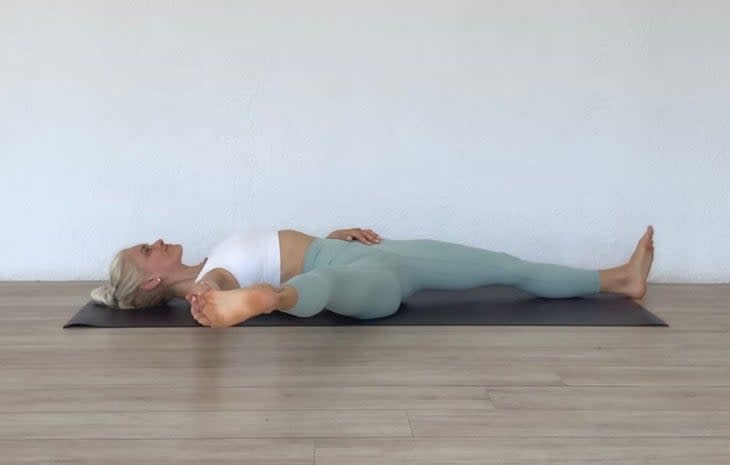
Reclining Hand-To-Big Toe Pose
This version of Triangle removes balancing from the equation. Instead, it allows you to gently stretch your hamstrings while you're fully supported by the ground, which places the focus squarely on the alignment of Triangle Pose.
How to: Start on your back, bend your right knee, and draw it toward your chest. You have several options for the bind: Wrap your first two fingers around your right big toe, hold onto your calf with your right hand, or loop a strap, belt, towel, or sweatshirt across the bottom of your foot and hold onto the ends with your right hand. Keep your shoulder blades touching the mat as you draw your lower ribs in and push through your right heel to start to straighten your right leg. Keep as much bend in your leg as you need. Slowly lower your right leg toward the right while flexing your toes toward your face to emphasize the hamstring stretch. It doesn't matter how far out to the side your right leg goes or doesn't go. It doesn't matter if it's completely straight. Just focus on the stretch. Breathe here. Repeat on the other side.
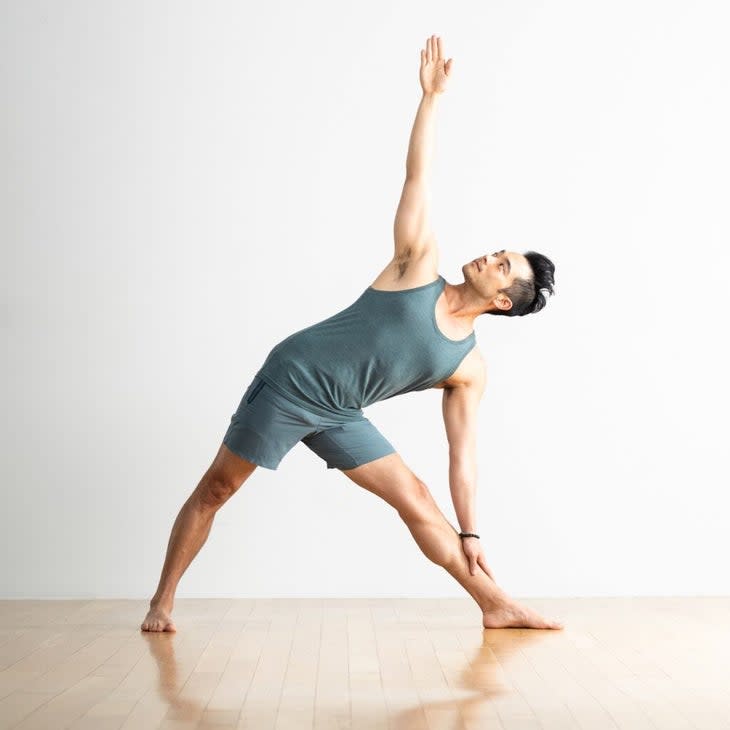
Triangle Pose
This fundamental shape helps your hamstrings and shoulders become accustomed to the demands of the nearly identical shape of Fallen Triangle that has a more disorienting relationship to gravity. By practicing Triangle first, you create a muscle memory of how your body needs to engage.
How to: Start in a Warrior 2 stance. Begin to straighten your right leg as you press your right heel into the mat. Draw your right kneecap toward your hip to engage your quads and stabilize your legs. Press down through the outer edge of your left foot to counterbalance. Inhale and lift through the top of your head to lengthen your spine. Exhale and bend from your hips as you lean your right shoulder over your right leg until you can't lean any more. Bring your right hand to your shin, a block, or the mat. Reach your left arm straight toward the ceiling with your palm facing away from you. Draw your lower ribs in and the front of your hips toward your ribs, as if you were initiating a crunch, to maintain engagement of your core. Breathe here. Repeat on the other side.
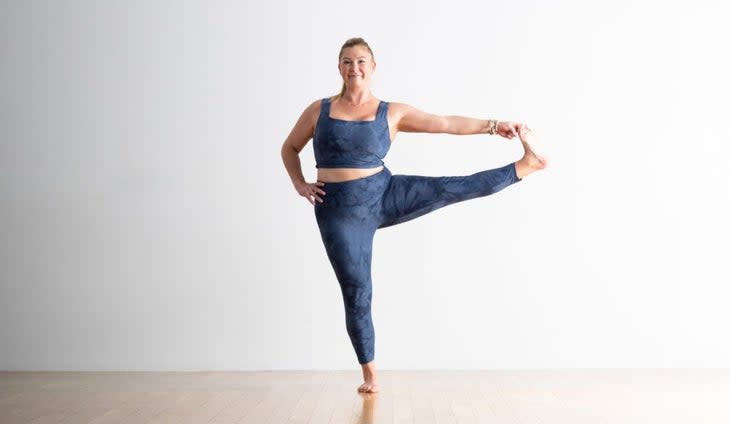
Standing Hand-to-Big-Toe Pose
How to: From standing at the front of the mat, draw your right knee toward your chest and clasp your big toe with the first two fingers of your right hand. Put your hand on your left hip for stability. Push through your right heel to extend your leg forward. Keep as much bend in your knee as you need. Stand tall as you reach through the top of your head. Keep your gaze straight ahead on a single point as you slowly start to bring your right leg out to your right side. Reach your left arm out to the left side. If you want, slowly take your gaze over your left shoulder. Breathe here. Slowly come out of the pose the same way you came into it. Repeat on the other side.
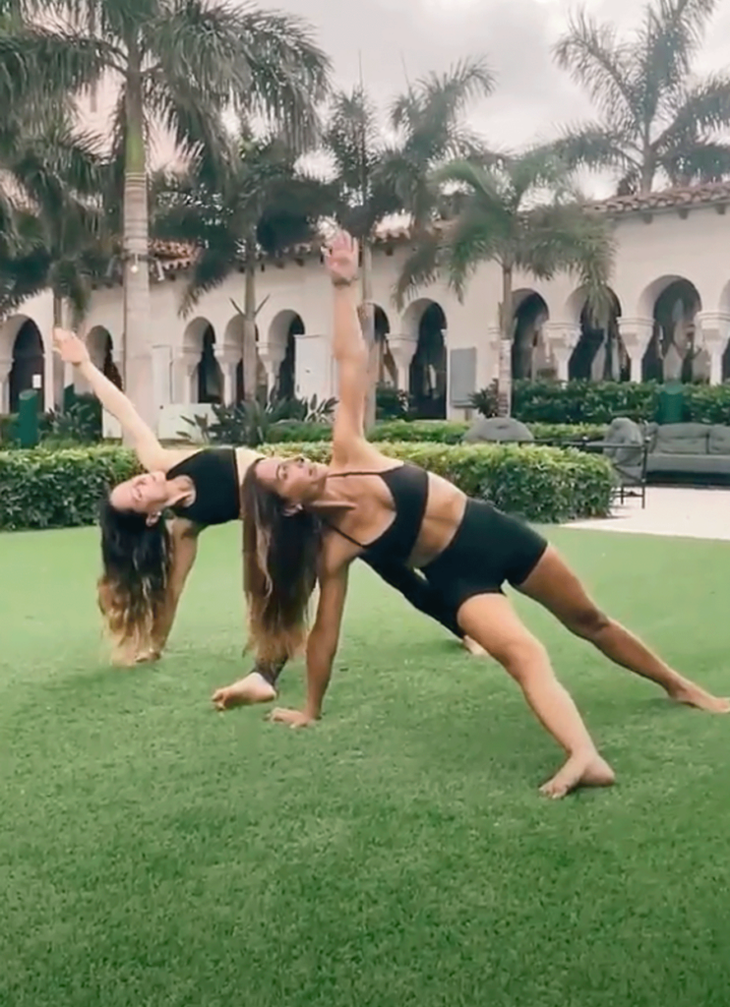
Fallen Triangle Pose
The shape of Fallen Triangle mimics aspects of both Triangle and Side Plank, given that you're supporting part of your body weight on one hand but falling back on the stability of both feet on the floor. Think of it as Side Plank with training wheels. It escalates the challenge, venturing into arm balance territory. Although the forward hand and foot do not touch as they might in Triangle, they're often approximately the same distance as they might be if you were bringing your hand to a block or your shin.
How to: Start in Downward-Facing Dog with your feet hip-distance apart and your hips lifted toward the ceiling. As you inhale, lift your right leg straight behind you. As you exhale, bring your shoulders forward over your wrists and draw your right knee toward your left elbow. Pause here as you rotate onto the inner edge of your left foot. Press through your right heel to straighten your leg out to the side and perpendicular to the mat. Lower your right foot to the floor to the left of the mat. Shift your weight into your right hand as you reach your left hand toward the ceiling. Press down through the edge of your left foot and lift your hips. Breathe here. Repeat on the other side.
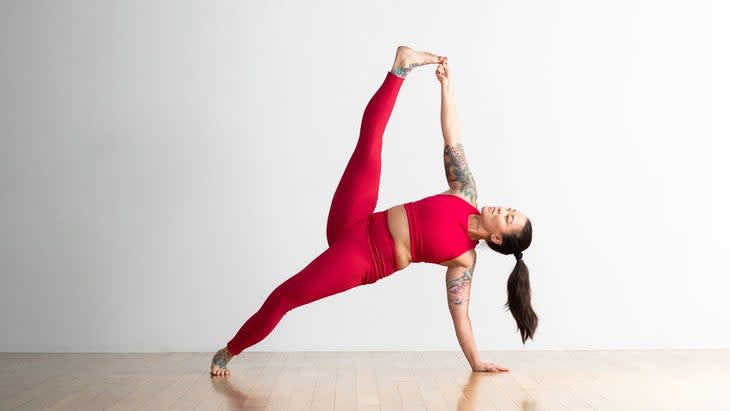
Side Plank Pose
The second-to-last version of Triangle is Side Plank with the top leg extended toward the ceiling and your fingers wrapped around the big toe, if that's accessible for you, or you can use a strap, belt, or sweatshirt looped around the arch of your foot.
There are many expressions of Side Plank. This one asks you to grasp the big toe of your lifted leg and extend that heel toward the ceiling, while balancing on your opposite arm and foot. You'll need to engage your core--and just about everything in your body--to keep yourself as steady as you can. (Or as close to steady as possible.)
How to: From Plank Pose, move your hands slightly forward so your wrists are where your fingertips were. Draw your shoulder blades against your back to create more stability in your shoulders. Roll onto the outer edge of your right foot and stack your left foot on top of your right or rest your left foot in front of your right on the mat. Keep your hips lifted. Draw your ribs toward your hips to prevent your lower back from arching. When you feel steady, bend your left knee and draw it toward your chest. Use your left peace fingers to grab your left big toe. Keep your gaze straight down at your right hand as you slowly start to press your left heel toward the ceiling and straighten your leg. Continue to lift your hips. Stay here or slowly shift your gaze toward your left thumb. Breathe here. Slowly come out of the pose the same way you came into it. Repeat on the other side
Tip: To create more stability, lower your right knee to the mat. For even more stability, pivot on your right knee to bring your shin and foot behind you, like a kickstand.
Similar Shape, Different Pose
There are several challenging arm balances in which the basic mechanics of Fallen Triangle are similar--but not exactly the same--as Triangle Pose. They include Eka Pada Koundinyasana, Visvamitrasana, and One-Legged Crow Pose. As you work with these poses, you'll recognize the same elements of alignment and engagement required by Triangle Pose. And that's what makes the practice rewarding--it enables you to see the familiar in new ways.
About our contributor
Ashlee McDougall is a self-proclaimed yoga nerd. She's completed more than 1,500 hours of yoga teacher training with expert teachers including Janet Stone and Jason Crandell. She enjoys creating sequences that help you build strength and mobility and is passionate about offering trauma-aware and inclusive classes. You can follow her on Instagram at @Ashlee.McDougall and take class with her at Yoga Loft in Tucson, Arizona.
For exclusive access to all of our fitness, gear, adventure, and travel stories, plus discounts on trips, events, and gear, sign up for Outside+ today.

